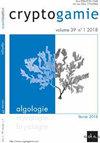Molecular Systematics of the Siphonous Green Algal Genus Codium in Eastern Victoria, Australia
IF 1.5
4区 生物学
Q3 MARINE & FRESHWATER BIOLOGY
引用次数: 0
Abstract
Abstract The widely distributed genus Codium is a major component of the marine macroalgal flora and has its largest species diversity in warm-temperate regions. Along the South coast of Australia, Codium is a diverse group, but the species diversity in the easternmost region of Victoria is not well-documented. In this study, we characterized the species diversity of Codium from Croajingolong National Park, Gabo Island Lighthouse Reserve and Cape Howe Marine National Park. The specimens were collected from a wide range of microhabitats during an expedition of the Bush Blitz program, and Codium species were delimited through a combination of molecular analyses of the chloroplast markers tufA and rbcL, and morphological observations. Six species-level clusters were found, corresponding to the native C. australicum, C. harveyi, C. lucasii.1 and C. fragile subsp. novae-zelandiae; and the exotic C. fragile subsp. fragile and C. tenue. The specimens of C. australicum showed variability in the architecture of the thallus that was attributed to the different habitats where they were collected. The utricles of C. harveyi were unusual in having a thick apical cell wall that protruded inwards and had internal projections. The species found in eastern Victoria are typical of the Flindersian and Peronian biogeographic provinces, and the low diversity of Codium species in this region is comparable to that of New South Wales.澳大利亚维多利亚州东部虹吸绿藻属Codium的分子系统学
Codium属分布广泛,是海洋大型藻区系的重要组成部分,物种多样性在暖温带地区最为丰富。沿澳大利亚南海岸,Codium是一个多样化的群体,但在维多利亚最东部地区的物种多样性没有很好的记录。本研究对croajingdragon国家公园、Gabo岛灯塔保护区和Cape Howe海洋国家公园的Codium物种多样性进行了研究。这些标本是在Bush Blitz计划的一次探险中从广泛的微生境中收集的,通过对叶绿体标记tufA和rbcL的分子分析和形态学观察相结合,对Codium物种进行了划分。共发现6个种级聚类,分别为原生C. australum、C. harveyi、C. lucasii。C.易碎亚种;novae-zelandiae;和外来的C.易碎亚种。C. tenue;australum的标本显示出菌体结构的多样性,这归因于它们收集的不同栖息地。哈维尔果的胞室不寻常的是有一个向内突出的厚的顶细胞壁和内部突出。在维多利亚州东部发现的物种是典型的弗林德斯和庇龙纪生物地理省,该地区的Codium物种多样性与新南威尔士州相当。
本文章由计算机程序翻译,如有差异,请以英文原文为准。
求助全文
约1分钟内获得全文
求助全文
来源期刊

Cryptogamie Algologie
生物-海洋与淡水生物学
CiteScore
2.60
自引率
7.70%
发文量
11
审稿时长
>12 weeks
期刊介绍:
Cryptogamie is a fast-track and peer-reviewed journal of international scope publishing in English only. It accepts original papers and review articles on the taxonomy, biology and ecology of all cryptogams. An issue of Cryptogamie may be devoted to a single topic, under the responsibility of guest editor(s). All articles published in Cryptogamie are compliant with the different nomenclatural codes. A copyright assignment will be signed by the authors before publication.
Cryptogamie, Algologie accepts articles on systematics as well as ecology and evolution of any kind of algae (including Cyanobacteria).
 求助内容:
求助内容: 应助结果提醒方式:
应助结果提醒方式:


